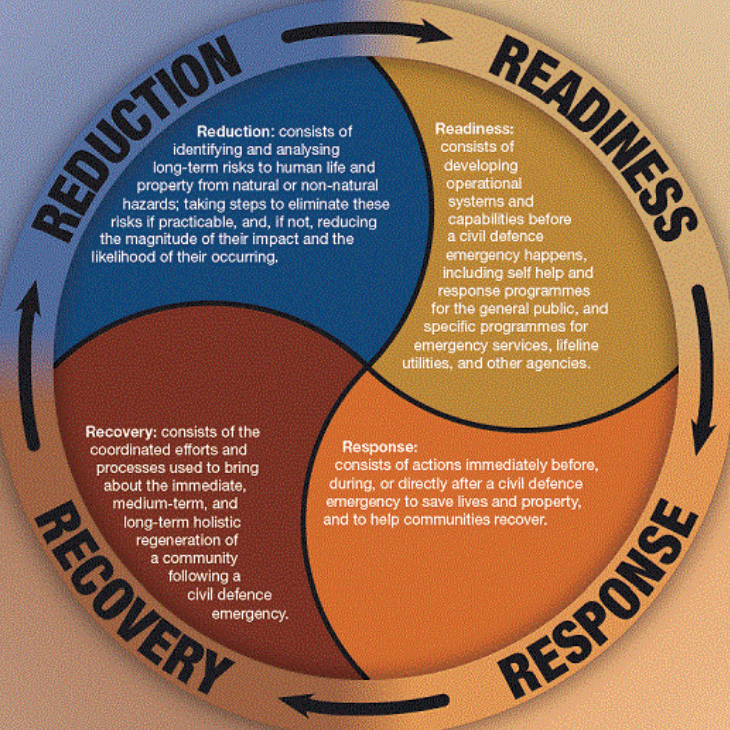
The 4 Rs: New Zealand's Integrated Approach to Emergency Management
Share
The 4 Rs: New Zealand's Integrated Approach to Emergency Management

New Zealand’s location on the collision zone of the Pacific and Australian Tectonic plates, make it prone to a lot of seismic activity and the potential of volcanic eruptions. Every year around 20,000 earthquakes are detected in New Zealand, however only about 10% of these are felt. Along with Earthquakes and volcanic eruptions there are multiple other natural hazards that present a risk to New Zealand.
Some of the Natural Hazard Risks in New Zealand include
Tsunamis: Being an island nation, surrounded by coastline, New Zealand is at significant risk of Tsunami Events. GNS Science reports that written records since the 1840’s indicate approximately 68 Tsunami have reached New Zealand shores, with some of them reaching 5 Meters in height.
Volcanic Activity: There are multiple active volcanoes in New Zealand, with most of them being in the North Island. The most recent volcanic eruption of note was the 2019 eruption of White Island, in which 22 people were killed, and many more injured. Most New Zealand volcanism in the last 1.6 million years has occurred in the Taupō Volcanic Zone (TVZ) which extends from Whakaari/White Island to Ruapehu.
Landslides: Landslides are another common natural hazard, particularly in areas with unstable slopes. Overseas we have seen some major landslides in which multiple people have died, and villages and cities were badly damaged.
Extreme Weather Events: New Zealand’s geographical location makes it subject to a lot of risk from a range of different weather events, including floods, droughts and severe storms.
So, what are we doing, and what can we do to better prepare for and deal with natural disasters in New Zealand? Here in New Zealand Civil Defence and the National Emergency Management Agency work with the 4 R’s approach which is made up of Reduction, Readiness, Response and Recovery.
Reduction: Minimizing Risks Before They Occur
The first and most important step in Emergency Management, is reducing the risks faced before a disaster strikes. This involved identifying long-term risks posed to human life, property and utilities, and then taking steps to either eliminating them, and if that is not possible, then minimizing them. The aim or reduction is to either prevent or lessen the impacts of disasters on the community.
Key Aspects of Risk Reduction include,
National Hazard Risk Reduction: The New Zealand government works hard to assess nationwide risks, for example, areas that are prone to earthquake damage, areas that are prone to flooding and potential volcanic activity. This is a simplified version of course, there are multiple other natural disaster risks posed to New Zealand. These assessments are ongoing and based on the information gathered, policies, regulations and legislation is put in place to help build community resilience against these risks.
Local and Regional Risk Reduction: Local and regional councils and authorities use the above information to develop specific strategies to mitigate, or reduce, the risk and hazards which are unique to their areas. This will include planning around the land-use, building stronger infrastructure, and creating better building codes to make structures and properties more resilient to hazards such as earthquakes and flooding.
Public Awareness and Education: One of the most important aspects of Risk Reduction also included educating the public about the potential hazards in their areas, and what they can to help prepare their homes and communities to withstand disasters.
Readiness: Preparing for Emergencies and Disasters
Despite all the best efforts to reduce risks, disasters can and do still happen, and don’t care about the time of the day or the season. They can strike with little to no warning and can be devastating. Readiness focuses on preparing individuals, communities, and emergency services to respond effectively when an emergency happens. Knowing about the risks is one thing, getting ready for and preparing for them is another altogether, for the general community and the public, this is potentially the most important step.
Key Elements of Readiness
Operational Preparedness: Emergency services, and essential utilities (such as water and power providers), Civil Defence, Red Cros and other emergency and rescue groups conduct regular training and simulations to ensure they are ready to respond and act promptly in an emergency.
Public Preparedness: The government spends a lot of time and effort encouraging the public to have an emergency plan, stock essential supplies, and have a disaster preparedness kit ready to go. Civil Defence, NEMA and the New Zealand government, run multiple campaigns and community-based events such as "Get Ready” and emphasize the importance of being self-sufficient during the immediate aftermath of a disaster.
Business Continuity Planning: Businesses play a crucial role in community resilience. They are encouraged to have continuity plans in place to ensure they can recover quickly and continue providing essential services.
So, what happens when disaster Strikes, we move on to the Response stage.
Response: Acting During an Emergency
Response refers to the immediate actions taken before, during, and directly after an emergency to save lives, protect property, and prevent further damage. A well-coordinated response minimizes chaos and maximizes the effectiveness of emergency services. This is where all the previous Readiness planning comes into its own.
Essential Components of Response
Evacuation Planning and Management: In the event of a major disaster, authorities may need to evacuate areas to keep people safe. Clear evacuation plans, designated shelters, and public information campaigns help ensure people know where to go and what to do in an emergency.
Emergency Services: Firefighters, USAR, Ambulance MIST Crews, Police, and other emergency responders act quickly to rescue people, contain hazards, and provide medical assistance.
Public Communication: Timely and accurate information is crucial during an emergency. The New Zealand National Emergency Management Agency (NEMA) and local authorities use social media, radio, and emergency alerts to inform the public of the latest developments and safety measures. There is a Memoranda of Understanding (MoU) with radio and TV broadcasters and CDEM which means they will work together to get vital information out to the public.
Recovery: Rebuilding After a Disaster
The recovery stage of the 4R’s is the process of restoring communities, infrastructure, and the economy following an emergency. This is a long-term process, as can be seen in Christchurch. It requires a coordinated effort to ensure that affected areas return to normal, if not more resilient than before.
Key Aspects of Recovery
Recovery Planning: Before disasters occur, frameworks are established to guide recovery efforts. These plans outline steps to restore essential services, provide financial aid, and support displaced individuals.
Recovery Managers: Designated professionals oversee the recovery process, ensuring that resources are allocated effectively and that rebuilding efforts align with long-term resilience goals.
Community Well-being: Beyond physical rebuilding, recovery also addresses emotional and psychological needs. Support services, counselling, and community initiatives help people cope with the trauma of disasters.
Conclusion
The 4 Rs—Reduction, Readiness, Response, and Recovery - form the backbone of New Zealand’s emergency management strategy. By focusing on risk reduction, preparedness, effective response, and long-term recovery, the country builds resilience against disasters and protects its people, environment, and economy.
It is important to note that everyone, individuals, businesses, and communities have a role to play in the 4 R’s. By staying informed, making preparedness a priority, and supporting recovery efforts, New Zealanders can ensure that when disaster strikes, they are ready to face the challenge and rebuild stronger than before.
